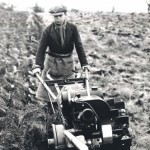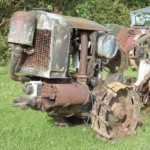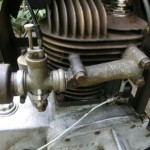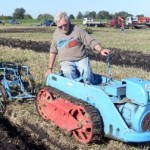Home › Forums › Groundcare Machinery › Grass Cutting Machinery › Allett Regal No.1
Tagged: Allett Regal Mk1
- This topic has 96 replies, 10 voices, and was last updated 1 year, 5 months ago by
 trusty220.
trusty220.
-
AuthorPosts
-
May 4, 2022 at 12:10 pm #38929
 trusty220Keymaster
trusty220KeymasterShortly after we exhibited at SALTEX last year Andrew Hall had an email enquiry from Allett Mowers at Hixon, Staffordshire, asking if he would be interested in restoring the very first Allett Regal motor mower originally built by Reg Allett back in 1965. Andrew passed on the enquiry to myself, and, well, the rest is history as they say!
It is now safely tucked up in the workshop waiting for me to start tinkering; this will be quite a challenging project as it is remarkably well preserved and so a complete strip down and repaint is out of the question. These things are only original once, and if you destroy that originality then it’s history is gone forever; as this will stand in the reception area in the factory it needs to look clean and tidy as well, so a rub down with an oily rag is definitely out of the question (or I risk being sent numerous dry cleaning bills from visitors!).
Anyway, just in case you weren’t aware of this type of machine, here is a brief history lesson:-
Back in 1965 a prototype 36″ cylinder mower was built and tested by horticultural engineer Reg Allett. One year later he manufactured and sold the first production Allett mower.
Known as the Allett 36in Mk1, the mower featured a 29hp water cooled, four cylinder petrol engine and gearbox from a Reliant 3-wheeler car.
Not surprisingly the mower generated a huge amount of interest both from prospective customers and the media. Not only was it smooth running, powerful and quiet but it sold at the same price as the other machines standing in the showroom of the lawnmower business established by Reg Allett in Stamford, Lincolnshire, in 1952.
Within a short time the Allett 36″ had become the professional groundsman’s mower of choice. Aimed primarily at maintaining sports fields, Allett mowers could be seen at work at all of England’s Test match venues by the end of the 1960’s; many county cricket grounds followed suit, as did major football clubs and sports stadiums throughout this country as well as Ireland and mainland Europe.Back to the present day and the mower that I have in the workshop is the very first production model, and so is a very important and historical machine. If you have never seen one of these before, here are some pictures of Reg Allett with the very same machine. When embarking on a project such as this it is very important to find as much information as possible, so these pictures will an invaluable asset in the next few weeks.
May 4, 2022 at 4:44 pm #38933 trusty220Keymaster
trusty220KeymasterHere are some pictures that I took of the mower whilst it was still at the factory. For it’s age it is in remarkably good condition and definitely needs preserving rather than restoring. A certain amount of paint re-touching will be necessary and the skill will be in blending it in with the existing paint.
May 4, 2022 at 8:49 pm #38944 trusty220Keymaster
trusty220KeymasterIt lives! After a considerable amount of time and swearing the engine finally burst into life this evening. If I were to paraphrase Eric Morecombe, all the parts were there but not necessarily in the right place; the ignition coil took it’s live feed off the positive side of the starter solenoid which meant that the coil was live at all times even with the key turned off. The wire used was taken off and it was just the right length to reach to the correct terminal on the back of the ignition switch, so I’m guessing it was part of the original wiring loom. The way it was wired up would prevent anyone turning the engine off and it would have been a fire hazard, so it was indeed lucky to survive!
The ignition coil was only the first step, unfortunately. The live feed was traced as far as the contact breaker points before it vanished. Luckily the engine has a Lucas distributor; my GT6 also has a Lucas distributor, so looking in the stock I carry for it I managed to come across a brand new set of points complete with all of the insulating washers and bushes. The old points had one insulator missing which had the result of connecting both sides of the points to earth, which effectively meant that there was no spark at the plugs. Once put back to how it should have been in the first place the engine fired up and ran. The only thing now is that it will not idle even though the throttle butterfly is closed, so the carburettor is going to have to come apart.
Onwards and upwards, at least it’s coming together.
-
This reply was modified 1 year, 11 months ago by
 trusty220.
trusty220.
May 5, 2022 at 6:29 am #38951 charlieKeymaster
charlieKeymasterGood progress. You will soon have it tuned up and ready for a bit of lawn mower racing!
May 5, 2022 at 4:41 pm #38955john-e-w
ParticipantThe engine is obviously OHV, so was it built for the original Mini – 750cc, low HP (27? 35?)
John E-W
May 6, 2022 at 6:18 am #38957 trusty220Keymaster
trusty220KeymasterThe engine block is cast aluminium and has “Reliant” cast into it, but I’m hoping that I can source various parts from Mini suppliers. It will need a full set of radiator hoses as well as an engine oil filter so I’m hoping that the original builders used commonly available items.
After talking briefly to Roy Allett he informed me that the engine block has wet liners, so I’m going to have to be careful not to let the internals of the block dry out or I risk the liner seals leaking into the sump.
Next on the agenda is a carburettor clean. That will be this weekend and then I should hopefully get the tick-over speed down to something approaching normal. Wish me luck!
May 6, 2022 at 12:07 pm #38959john-e-w
ParticipantI think Reliant used the basic engine for the mini and had mods made to suit the Reliant – I think they later moved to an all alloy, slightly larger and more powerful, Imp engine.
I have found that the biggest problem with wet liners, is that they are normally a loose fit in the block and might come out with head removal. To overcome that – tap one end of the head sideways after removing bolts and before lifting vertically. However, assuming that it isn’t showing signs of requiring a complete break-down and not burning oil, I would leave well alone.
Voice of experience speaking!!
Regards John E-W
May 6, 2022 at 4:56 pm #38960 trusty220Keymaster
trusty220KeymasterThat was exactly what I was going to do- leave it alone! When I was running it the other day the only adverse noises that I could hear were an excessive tappet noise. Roy Allett says that one of the service mods done on them during their working life was to set inlet and exhaust valves both to 8 thou. I will investigate over the weekend and let you know what they are at present!
May 6, 2022 at 5:37 pm #38961 wristpinParticipant
wristpinParticipantThe engine is obviously OHV, so was it built for the original Mini – 750cc, low HP (27? 35?)
Are you sure ?
May 6, 2022 at 7:03 pm #38962andyfrost
ParticipantI was thinking the same Angus , I always thought Reliant built their own engines in house , as did BMC and Rootes , not absolutely certain , but stand to be corrected.
Andy.
May 6, 2022 at 9:10 pm #38963 wristpinParticipant
wristpinParticipantCertainly the Mini that reached production had the BMC A series engine; that’s not to say that other engines were not considered but I’ve never heard of the Reliant connection. The Hillman Imp had a version of a Coventry Climax lump, originally designed for portable fire pumps. In the Imp it was dry liner, I have an original Rootes workshop manual- and the original £15pa tax disc for my Imp, the second one sold by the local Rootes dealer in May 1963. Wish I still had it.
As far as working on wet liner lumps goes, it’s standard practice to fit “ keepers” that bridge across the block and edge of a liner to stop the lifting off the bottom seal, often a big O ring. Until that’s done the crank must not be rotated.May 8, 2022 at 6:49 pm #38976 trusty220Keymaster
trusty220KeymasterI’ve spent most of the day on the Allett today. First off was to remove the grassbox and carrying brackets- I’ve got enough lumps on my shins from walking into Mastiff brackets so I’m determined not to add to the collection. Even the grassbox has had a lot of thought behind it so that the carrying bolts will act as pivots to empty it; the washers behind the bolts are stepped to provide a bearing surface on the carrying arms. I always thought that these mowers would be young enough to be made with UNF threads but all of the grassbox bolts and nuts are BSF. This theme was carried through to the thrower plate behind the cylinder, so I’m guessing that the whole mower is BSF throughout. Contrast that with the Reliant engine which seems to be UNF so far and it means that I’ve got most of my toys out of the box. I haven’t come across any metric threads yet but I won’t make any rash predictions at this stage.
First major target for the day was to get the engine running properly, so off came the carburettor for a thorough clean inside and out. I always find that brake cleaner works the best on baked-on dirt on the outside but in this case it was that stubborn I had to soak it in a bath of petrol then rub it with fine wire wool. Several applications later it was good enough to pass muster so I started putting it back together; luckily there was nothing really wrong with it and the excess fuel causing the engine to run too fast was down to the choke assembly sticking inside the body of the carb. The actuating arm on the outside was in the correct position but the internal mechanism is pushed back to the “off choke” position by a spring- this was stuck with debris, so a good clean achieved the desired result.
In order to remove the carb. it was necessary to take off the rocker cover so that I could reach the nut on the inside of the flange. Whilst the cover was off I took the time to address the rattling tappets. The gaps varied between 6 thou and 12 thou in no particular order, so they were all adjusted to 8 thou as recommended by Roy Allett. He really is a mine of information and when he called me on Friday he gave me quite a few pointers from the time he used to make and market these machines. Apparently the factory used to remove the thermostats from the engines as well and block the bypass hose with a cork to improve the flow rate through the tiny radiator to prevent overheating in the summer months. This is something we used to encounter with some of the Ransomes machinery if lazy operators didn’t keep the radiator screens clear of grass cuttings, so I can entirely relate to his comments!
Anyway, all put back together and I fired the engine up again. The rattling had almost disappeared completely and once the engine reached operating temperature the choke was pushed in and the revs dropped down to an acceptable level. With a few adjustments a lovely slow and even tick-over was achieved, so target achieved and a well-earned beer downed!
May 8, 2022 at 11:29 pm #38984 wristpinParticipant
wristpinParticipantFirst off was to remove the grassbox and carrying brackets- I’ve got enough lumps on my shins from walking into Mastiff brackets so I’m determined not to add to the collection.
When it comes to the ability to inflict injury while not running and stationary I think that the prize may go to the extended axles on the Auto Certes and later Super Certes, with my Stiga/Mountfield bendy’s towing drawbar a close runner up.
May 9, 2022 at 8:05 am #38990 trusty220Keymaster
trusty220KeymasterI think the prize would go to the front A-frames on the Ransomes Motor Triple. How many people have been knocked senseless by taking the pin out and forgetting that the frame is sprung loaded? I haven’t, but know of one or two in the day.
May 9, 2022 at 9:02 am #38991 daveParticipant
daveParticipantPicture no 14. Is that your best table cloth? Get it in the washing machine quick before
Mrs R, she who has to be obeyed finds out.
For cleaning carbs etc I use 28 second heating oil and an ultrasonic cleaner.
The job is beginning to look good. -
This reply was modified 1 year, 11 months ago by
-
AuthorPosts
- You must be logged in to reply to this topic.















